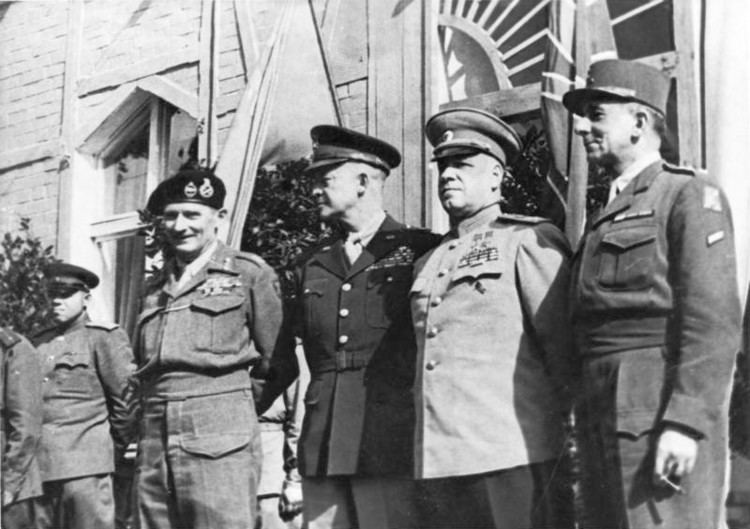 | ||
By the Berlin Declaration (German: Berliner Erklärung/Deklaration) of June 5, 1945, the four govermments of the United States, Soviet Union, United Kingdom, and France, acting on behalf of the Allies of World War II, jointly assumed "supreme authority" over German territory; and asserted the legitimacy of their joint determination of issues regarding its administration and boundaries, prior to the forthcoming Potsdam Conference.
Contents
The preamble of the declaration confirmed the complete legal extinction of Nazi Germany, following the death of Adolf Hitler on 30 April 1945, but the continued subsequent existence of a German national territory which for the purpose of the Declaration was taken to be as defined on 31 December 1937, although subject to the four signatory powers also asserting their authority to determine the future boundaries of Germany; an authority that would shortly be exercised in the incorporation of eastern territories into Poland and the Soviet Union. The preamble also confirmed the four nominated representatives of the Governments of the United States of America, the Union of Soviet Socialist Republics and the United Kingdom, and the Provisional Government of the French Republic as the "Allied Representatives" who would from then on exercise supreme civil and military authority within German territory and over former German forces. Otherwise the text of the declaration was that prepared for, but not eventually used in, the German Instrument of Surrender of 8 May 1945, in the form previously agreed by the European Advisory Commission; but not including the 'dismemberment clause' proposed as being added to the agreed surrender instrument at Yalta.
At the time, the Alles maintained that with this declaration, the German state ceased to exist. However, that contention has since been challenged in legal and political debate.
Signatories
The declaration was signed by the Allied commanders-in-chief:
Further developments
The military forces of the Western Allies had pulled back westwards from the original "Line of contact", transferring the administration of the vacated territories into the Soviet occupation zone; at the same time taking over administrative responsibilities from Soviet forces for their respective sectors of Berlin. Subsequently, the Potsdam Agreement of 2 August 1945 confirmed the establishment of British, American and French zones of occupation, and set the boundary between Poland and Germany at the Oder-Neisse line; the former German territories east of this line now coming under Polish and Soviet (Kaliningrad Oblast) administrations, pending the final apportionment of territories in a future Final German Peace Treaty. This treaty was delayed due to ideological and political differences between the Allied Powers, and was only finally ratified in 1991 as the Treaty on the Final Settlement With Respect to Germany entered into force, formally ending the Occupation of Germany.
An Allied Control Council was established on 30 August 1945 to execute the governmental power in Allied-occupied Germany, which now did not include the German eastern territories.
Commemoration
A monument has been erected at the site in the Wendenschloss district of Berlin-Köpenick on Niebergall Street which reads in German:
On 5 June 1945 in the former headquarters of Marshal G. K. Zhukov here, the representatives of the high commands of the Anti-Hitler Coalition signed the Declaration of the defeat of Fascist Germany and the assumption of governmental authority through the four allied states.
